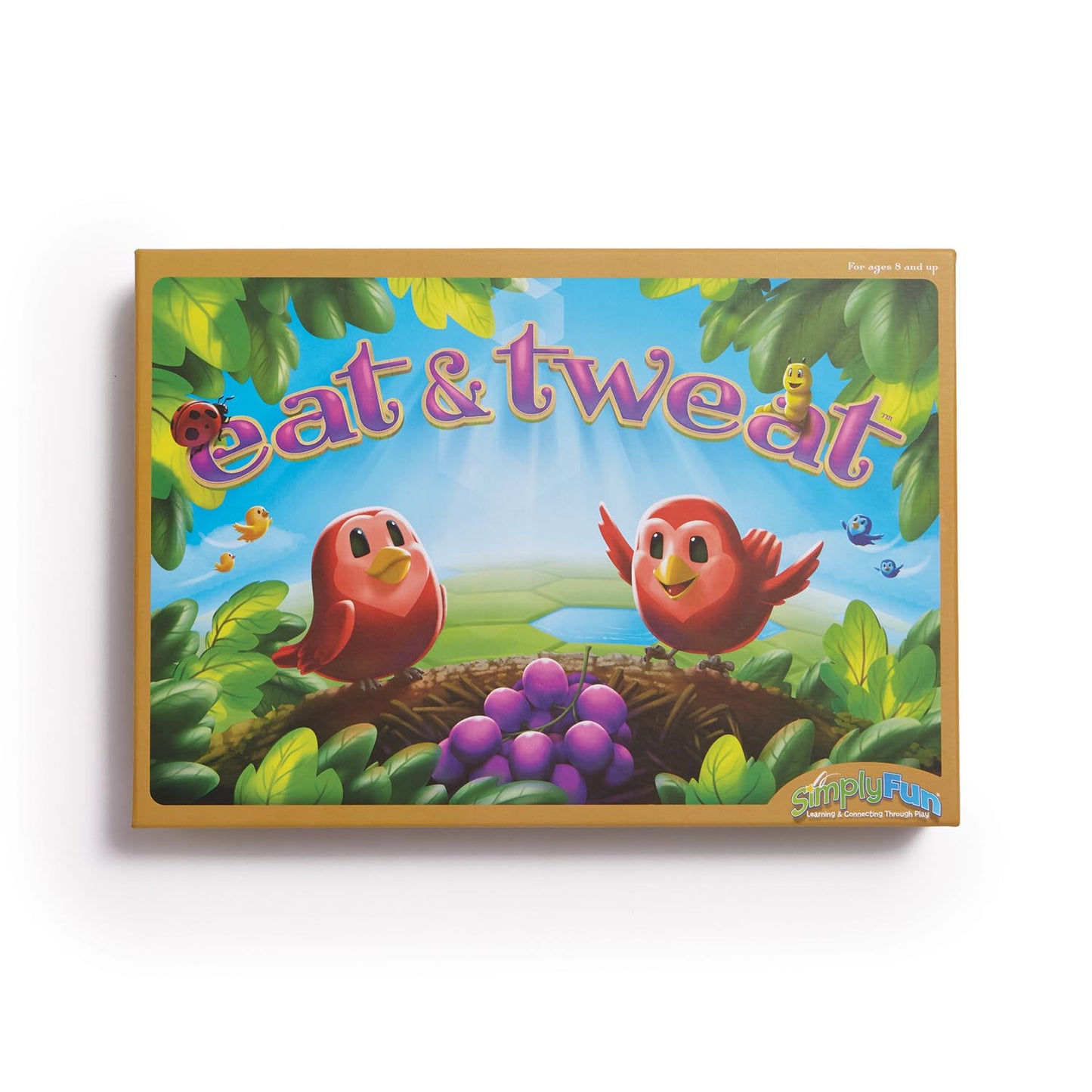


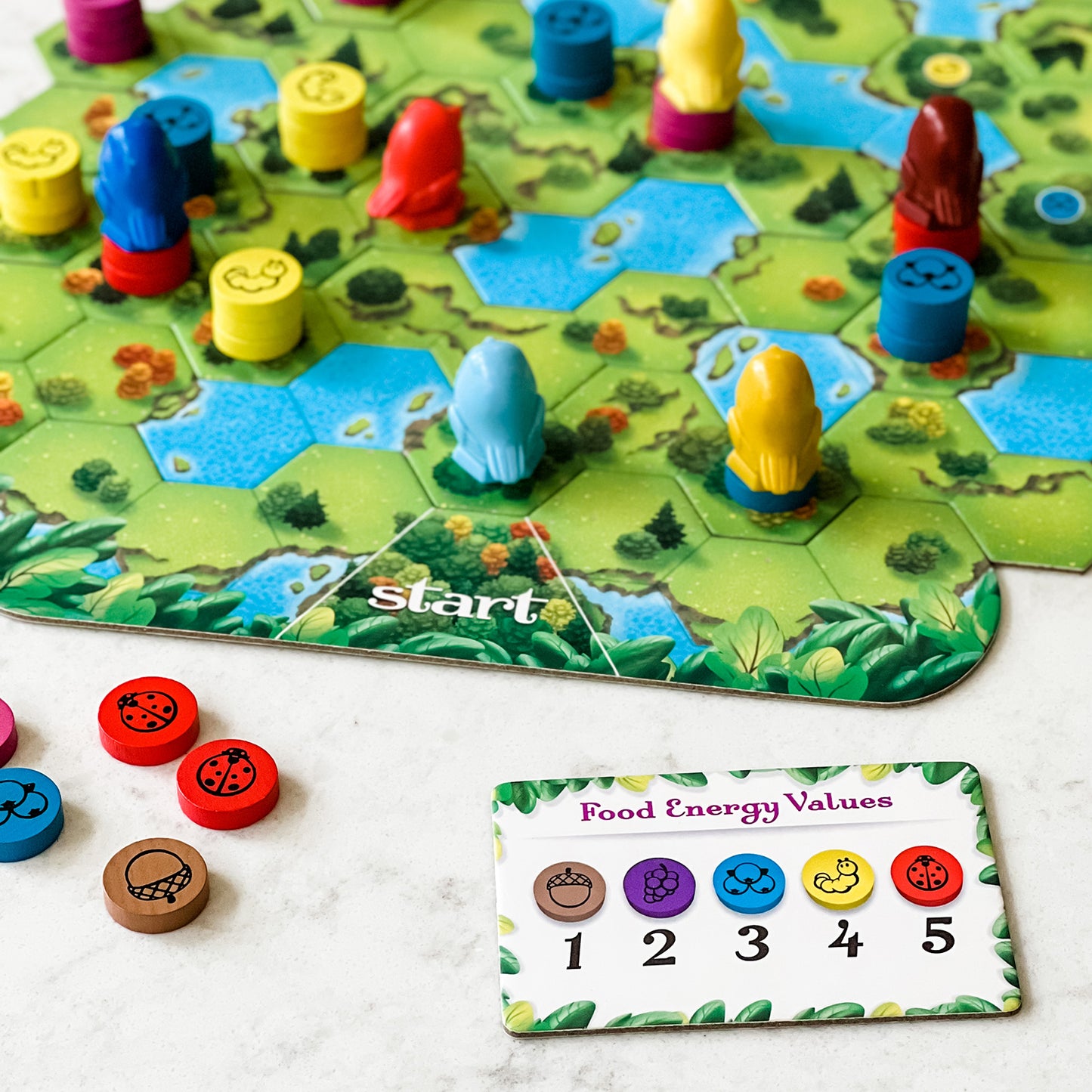
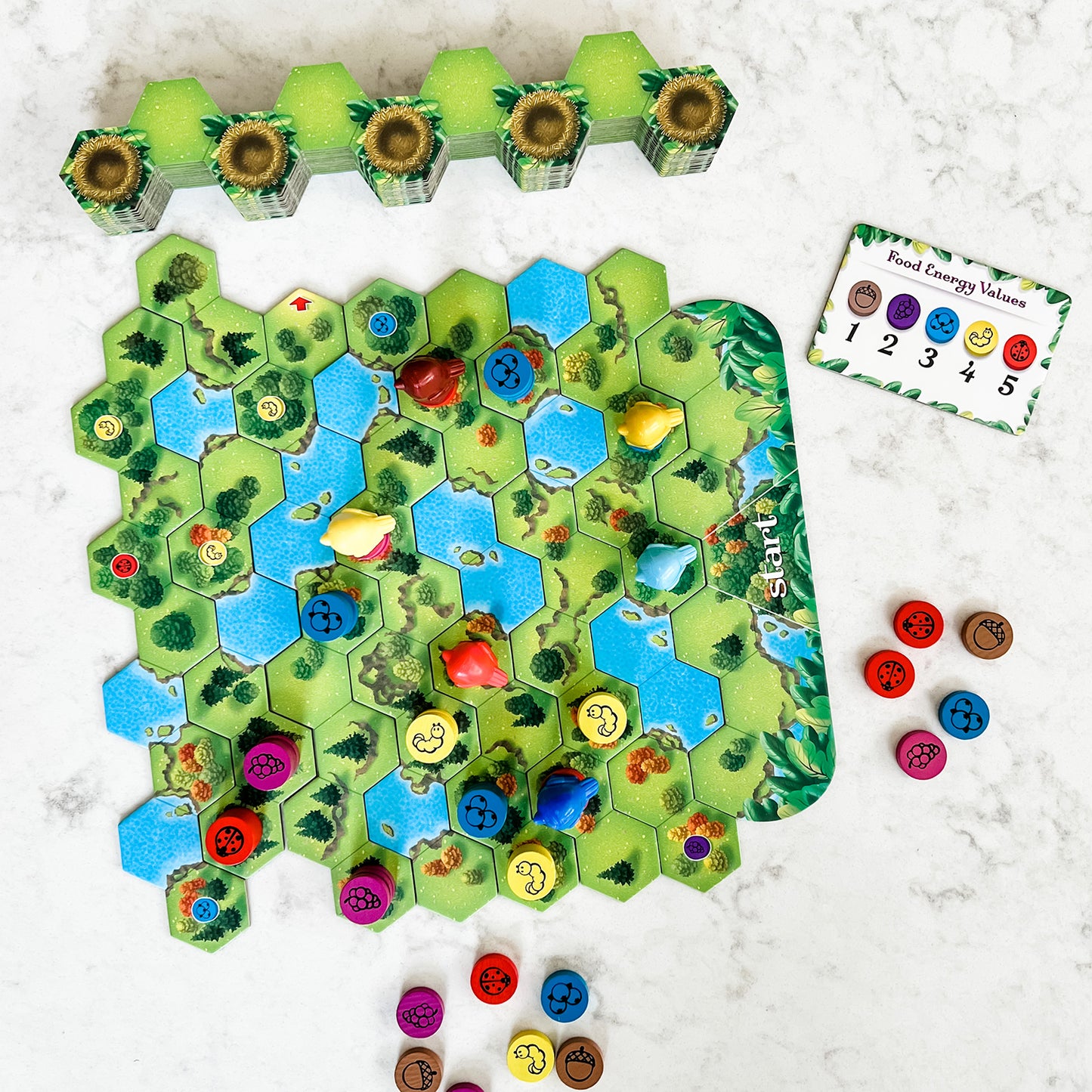
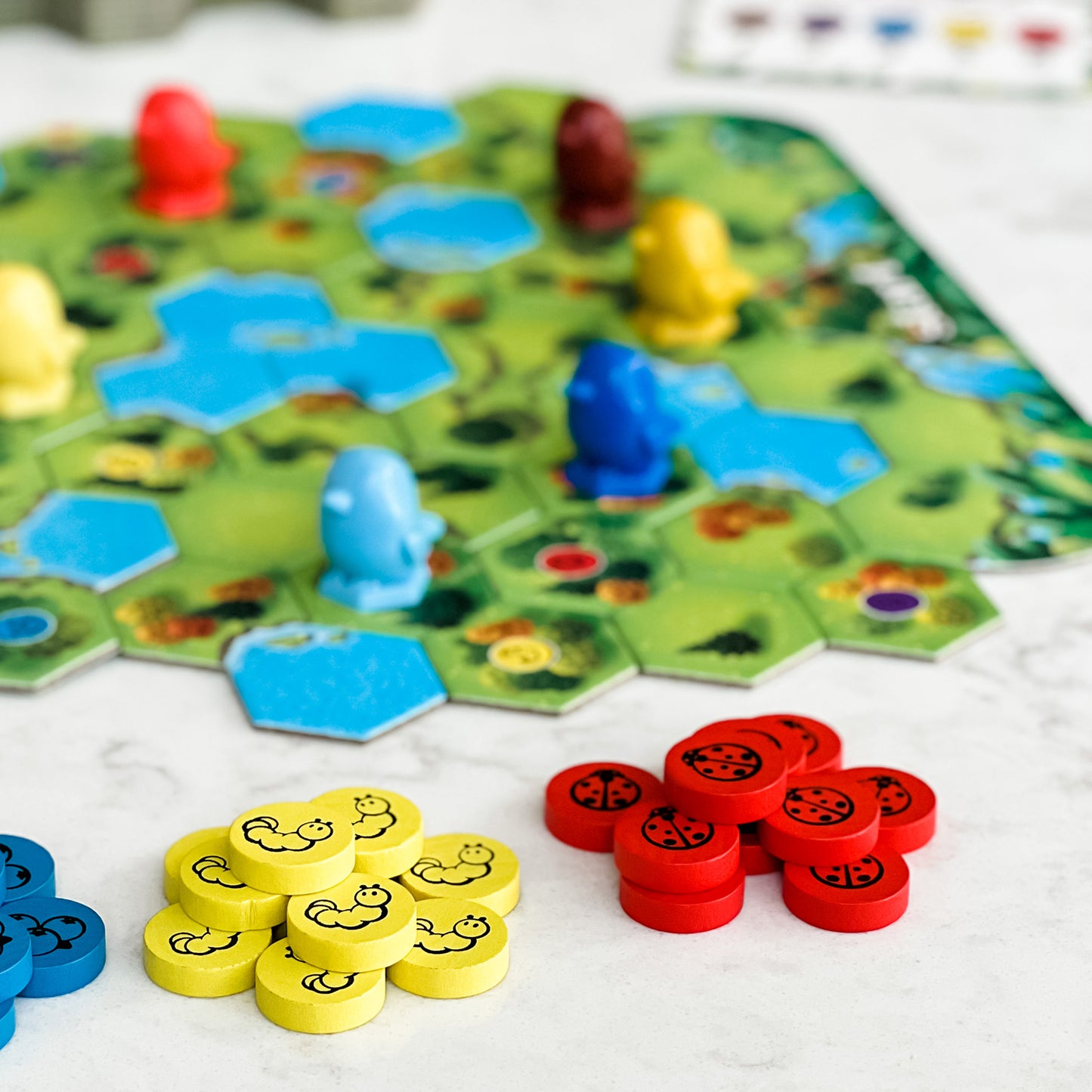
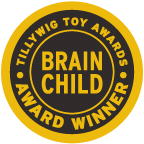
Collapsible content
Today, we’ll learn how to play Simply Fun’s Eat & Tweet, a game of planning and strategy where you help your birdies fly home to their nests as they collect tasty tidbits of food to help them on their way.
Eat & Tweet is for 2 to 6 players, ages 8 and up.
In each Eat & Tweet game box, you get:
• One starter tile
• twenty landscape tiles
• six plastic colored birds
• fifty-one wooden food energy chips
• two food energy reference cards, and
• one rule booklet
Eat & Tweet is a great game for teaching your kids tactical planning skills as well as food and energy management. All from a bird’s point of view!
To set up the game, mix up the 20 landscape tiles and place them in a draw pile, nest side up. Place the food energy chips in groups by color beside the play area. These chips are the Main Food Energy Supply. Then, place the start tile at one end of the play area, take the top 3 landscape tiles from the pile, turn them over and connect them to the start tile so that all 9 spaces connect. You’ll place each subsequent tile in line with the top edge of the previous tile – like this – unless the previous tile shows a red arrow icon on one side. If that happens, the next landscape tile must be shifted either one space to the left or one space to the right..
Now, place the food energy chips on the landscape tiles as indicated by the icons.
Finally, place all the players’ birds in the starting space of the start tile.
To begin play, decide whether players play individually or in teams of 2. If individually, players each take a bird in the color of their choice. If in teams, players should choose birds of similar colors – for example, a dark blue and a light blue go together. Turns proceed clockwise, so players on teams should arrange themselves around the table in alternating order, to allow opposing team members to play before a team partner goes.
Before the first player goes, all players receive their starting food energy chips which are distributed based on the player’s starting position (show assignments and values as per rule book).
On each turn, a player MUST fly to a space with a food energy chip or a nest. Players can fly through all spaces EXCEPT those with water, a food energy chip, another player’s bird, or a nest on it. To proceed, players need to fly AROUND those spaces, and must stop when landing on a space containing a food energy chip.
Watch out that you don’t get blocked. If you get blocked, your turn is over.
In Eat & Tweet, the number of spaces moved equals the amount of energy used. After landing on a space, each player must remove the right amount of energy from his own supply and add it to the Main supply. After “paying” for the trip, the player may take the chip from the space he landed on and add it to his own supply. Players must ALWAYS turn in the energy for the trip FIRST, and THEN take the new food energy chip. After each exchange, a player’s turn is over and the next player goes.
All birds must be able to see at least 3 landscape tiles ahead. If there are two or fewer tiles in front of each bird, tiles must be added until there are three in front of all birds. . Food energy chips are placed on the new tiles as they were at the beginning of the game from the main supply.
All birds are also only able to see 3 tiles behind. Landscape tiles that are more than 3 spaces BEHIND all the birds are removed from the game and any unclaimed energy chips go back into the Main supply.
When there is only one landscape tile left in the pile, it is connected to the previous tile as before, but WITHOUT TURNING IT OVER so that the 5 nest spaces are visible. This becomes the Nest Tile.
Once the nest tile is connected, a player can fly to the nest space, which is the ending space, after which the player may no longer take turns.
The game ends when all players have landed safely on their nests. Then it’s time to calculate the value of the food energy chips each player still has in his pile. The player with the most points wins. In case of a tie, the player who got to the nest first is the winner. If playing in teams, the team with the highest total wins.
Keeping enough energy to fly can be difficult. Plan your moves carefully to Eat & Tweet your way to your nest with as much spare food energy as you can!


Core Standard*: Math
Math
- Mathematical Practice
- Make sense of problems and persevere in solving them, and/or make use of structure. Grade Levels 3rd, 4th
- Look for and make use of structure. Grade Levels 3rd, 4th


Explore
What Does Child Do To Use Skill In The Game?
Players are examine at the board throughout the Eat & Tweat as they consider their next moves.
How Parents Can Assist Learning
Remind children to look at the board carefully during play, making sure to identify where the Food Energy Chips are located and possible flight paths they can take based on their current total Food Energy. This will discourage impulsive actions.
Learning Implications and Educator Support
Playing Eat & Tweat helps children develop spatial reasoning skills, situational analysis, risk assessment and perspective changing. Educators can help social emotional development of patience and persistence by asking kids to explore the game board completely before making a move. This involves visual exploration and mental modeling of different scenarios.
Determine
What Does Child Do To Use Skill In The Game?
Players need to determine the best location to place a fly their Bird, considering the net value of the destination Energy Food Chip minus the energy it takes to obtain the Chip. They also need to consider defensive or offensive flight paths depending on location of other players' Birds.
How Parents Can Assist Learning
Parents can explain various strategies, so that children can add to their thinking in making a decision. For example, "This Energy Chip is worth 3 but takes 4 energy to obtain; but this other Energy Chip is worth 2, but only takes 1 energy to obtain. Which path earns you more energy?" Eat & Tweat is good for teaching risk and reward analysis, as well as a combination of offensive and defensive strategies. Encourage children to consider a range of options such as flying backwards or flying forwards more than 5 energy points.
Learning Implications and Educator Support
Eat & Tweat involves examining the board and creating mental models of the consequences of moving Birds to eat different Energy Food Chips. When first learning to play, players will think about consequences of the immediate move. As they become more proficient, children will think about multiple moves ahead in order to evaluate which Energy Chips to pursue either for gaining points or preventing opponents from gaining points. Eat & Tweat is also good for teaching risk/reward analysis, as well as a combination of offensive and defensive strategies. Encourage children to consider a range of options such as flying backwards or flying forwards more than 5 energy points. Educators can explain various strategies, so that children can add to their thinking in making a decision. For example, "This Energy Chip is worth 3 but takes 4 energy to obtain; but this other Energy Chip is worth 2, but only takes 1 energy to obtain. Which path earns you more energy?"
>Compare
What Does Child Do To Use Skill In The Game?
Players compare their position on the board with those of opponents, as well as the position of their Bird relative to the Food Energy Chips and Nests.
How Parents Can Assist Learning
Ask children to describe aloud the potential reward and cost for different flight paths in order help them identify best options for playing their Bird. Ask specific questions such as, "Look at these two Food Energy Chips. Which would be a better place to fly your Bird?"
Learning Implications and Educator Support
Eat & Tweat helps children develop complex comparison skills as they simultaneously consider the location of their Bird relative to Food Energy Chips and nests, and relative to other Birds. This also involves perspective changing as a child thinks about what other players may do in response to the next move the child's Bird. Further, Eat & Tweat helps develop spatial reasoning, risk/reward analysis and directionality.
Predict
What Does Child Do To Use Skill In The Game?
Players predict where they think other players will fly their Birds.
How Parents Can Assist Learning
Playing Eat & Tweat helps children develop spatial reasoning skills, situational analysis, risk assessment and perspective changing. Parents can ask a child to recall what an opponent did on prior turns. Then, ask what they think the opponent will do on their next turn. This use of perspective changing helps the child predict what their opponent may do and, therefore, influence where the child flies their Bird.
Learning Implications and Educator Support
Playing Eat & Tweat helps children develop spatial reasoning skills, situational analysis, risk assessment and perspective changing, all skills that can be used to make more accurate predictions of opponents' moves. Additionally, making predictions requires analysis, observation, empathy and interpretation. Educators can encourage children to discuss their options and to declare whether they want to make an offensive move (ex: fly a Bird to gain the most points on a turn) or defensive move (ex: fly a Bird to create an obstacle to an opponent, even if the move may cost the child some energy) prior to playing their Bird.
Plan
What Does Child Do To Use Skill In The Game?
Players need to think about where to fly their Bird and how to fly there to obtain the most points.
How Parents Can Assist Learning
To be successful in Eat & Tweat requires thinking about consequences beyond a player's immediate move. This type of long-term, sequential thinking is important beyond the game for activities such as building forts, making art, successfully completing schoolwork on time and launching a new business from a lemonade stand to a company later on in life. Discuss options available on each turn to help children think about potential outcomes.
Learning Implications and Educator Support
Planning is an important skill for developing strategic thinking, persistence and reaching a goal. Encourage the children to discuss the goal throughout the game and how they might move their Bird to reach their goal. Additionally, to be successful in Eat & Tweat requires thinking about consequences beyond a player's immediate move. This type of long-term, sequential thinking is important beyond the game for activities such as building forts, making art, successfully completing schoolwork on time and launching a new business from a lemonade stand to a company later on in life.
Experiment
What Does Child Do To Use Skill In The Game?
Players can experiment with different approaches to winning the game, adopting offensive strategies or defensive strategies.
How Parents Can Assist Learning
Eat & Tweat is good for experimenting with strategy and tactics. Discuss different strategies prior to starting the game and encourage the child to select one. Play the game and discuss. Then, play again with the child trying a different strategy. Discuss again and compare the advantages and disadvantages.
Learning Implications and Educator Support
Eat & Tweat is good for experimenting with strategy and tactics. Discuss different strategies prior to starting the game and encourage the child to select one. Play the game and discuss. Then, play again with the child trying a different strategy. Discuss again and compare the advantages and disadvantages.
Practice
What Does Child Do To Use Skill In The Game?
Each turn in Eat & Tweat is practice for learning strategy.
How Parents Can Assist Learning
Parents can engage children in conversation about their choices in order to help children understand different risks and benefits in their strategy.
Learning Implications and Educator Support
As a strategy game, Eat & Tweat has several implicit levels of mastery. Therefore, the more children play the more capable they will be in developing and executing increasingly sophisticated strategies. Also, as they become proficient, they will be able to teach others. Teaching others demonstrates mastery, the final stage of learning, and is wonderful for building self-esteem, confidence and intrinsic motivation.
Solve
What Does Child Do To Use Skill In The Game?
This game involves many intermediate solutions (e.g. obtaining Food Energy Chips) and a long term solution (having the most points at the end of the game). As the game progresses, players may change strategies, such as shifting from offensive efforts to obtain Food Energy Chips to defensive effort to stop others from getting Food Energy Chips.
How Parents Can Assist Learning
Parents can talk to children about alternative approaches and help them think about choices. Remind the child to look at several options and evaluate the benefits and risks for each turn. It is important for parents to not create the approaches, but help the children come to their own conclusions. Parents can encourage both offensive and defensive game strategy.
Learning Implications and Educator Support
Eat & Tweat involves uses of spatial reasoning, directionality and if/then problem solving. After children have mastered the rules of flying the Birds, they learn new information constantly during game play. This information directly effects how children strategize an approach for moving Birds, and ultimately solving the game. Educators should encourage children to explore the whole board to locate the various sites where they can obtain Food Energy Chips, including behind their Bird. Also encourage comparison of sites for determining cost and benefit of various moves. Eat & Tweat is good for developing flexible thinking skills as children evaluate their options rather than just move a Bird to the closest Food Energy Chip. This also helps develop overall adaptability as children change strategy or approach based on changing circumstances caused by the play of opponents.
*Data compiled from CCSSI ELA Standards, WA Science Standards, and Washington Social Studies Standards


Cognitive
Suggestions for How to Modify Play Experience
Not appropriate for children with cognitive delays, unless they can do simple addition and subtraction, and play a game like checkers where they have to think about moving around other pieces.
Eat and Tweat is best played with strategy. For children with cognitive concerns, play without for concern for strategy. Play for turn-taking and practice with adding and subtracting.
Play without adding and subtracting. Instead, see who can get the most Food Energy Chips of any color by just landing on a food source.
Communication
Suggestions for How to Modify Play Experience
No communication is required, but explanation of moves and strategies can be encouraged to promote conversation.
Discuss optional moves and possible different results. For example, "Where else could you have moved? How would the result be different?"
Sensorimotor
Suggestions for How to Modify Play Experience
If the child has difficulty with the small pieces, the child could point to where he wants to go and have another player move his Bird. The child can then verbalize what should take place with the Food Energy Chips.
Social Emotional/Behavioral
Suggestions for How to Modify Play Experience
Children who have difficulty with frustration tolerance may need support to keep calm when they are blocked by another player or when another player lands on the energy source they wanted to go for. Reflect their frustration, such as "I know that made you mad. Let's look for another good option."
Children who are impulsive may need encouragement to explore all of their options instead of just looking at the closest energy source.
Vision
Suggestions for How to Modify Play Experience
This game is not appropriate for children with low vision.
The writing on the cards may be difficult for children with vision concerns to see. Use a magnifying glass, if needed.
Hearing
Suggestions for How to Modify Play Experience
Children with hearing concerns can play Eat and Tweat, but it would be helpful to have paper and pencil to write down the energy exchanges. Sign language can also be used.
*Data compiled from CCSSI ELA Standards, WA Science Standards, and Washington Social Studies Standards


Autism Special Considerations
Appears to ignore other's communication and/or has difficulty giving eye contact to a communication partner
Is This Game Appropriate for Child with Characteristic? Yes
Can Child with Characteristic Play Game w/o Modification? Yes
Strategies for Developing Compensatory Skills:
Although verbal communication is not necessary, players must watch and listen to others moves to plan a strategy and know how many Food Energy sources have been acquired by the other players. Encourage children to verbalize what they did, as well as what they see others do.
Has difficulty understanding complex verbal directions
Is This Game Appropriate for Child with Characteristic? No
Can Child with Characteristic Play Game w/o Modification? No
Strategies for Developing Compensatory Skills:
Directions for Eat and Tweat are complex, in that the colors and symbols on the Food Energy Chips have a different meaning, Birds can only move in certain ways depending on where they are on the board, and players need to be aware of other's moves to plan a strategy. For this reason, the game may not be appropriate for children with autism or other cognitive and social comprehension concerns.
Uses vocabulary inaccurately or demonstrates echolalia (repeating another's speech)
Is This Game Appropriate for Child with Characteristic? Yes
Can Child with Characteristic Play Game w/o Modification? No
Strategies for Developing Compensatory Skills:
Having echolalia should not prevent a child from playing, but may be annoying to other players. The adult can provide alternatives for the child. For example, if the child is repeating a phrase, say, "Tell me about your Bird."
Gets stuck repeating a verbal topic or physical actions and/or has difficulty attending to others' actions or topic.
Is This Game Appropriate for Child with Characteristic? Yes
Can Child with Characteristic Play Game w/o Modification? No
Strategies for Developing Compensatory Skills:
Children with autism may have a preferred color or pattern to move. This is fine if the goal is to just engage in game play. If the goal is to learn how to play with strategy, this game may not be appropriate for these children.
Has difficulty producing speech/communication
Is This Game Appropriate for Child with Characteristic? Yes
Can Child with Characteristic Play Game w/o Modification? Yes
Strategies for Developing Compensatory Skills:
Communication is not necessary, but should be encouraged. Ask the child to explain why they moved where they did and how many points they earned. Adults might also request that the child demonstrate and talk about the value of exchanges of energy sources.
Has difficulty sequencing multi-step actions and/or doing complex abstract tasks
Is This Game Appropriate for Child with Characteristic? No
Can Child with Characteristic Play Game w/o Modification? No
Strategies for Developing Compensatory Skills:
Eat and Tweat is not recommended for children who cannot process multiple steps. Each turn in the game requires multiple steps of moving a Bird, removing a Bird, and taking a Food Energy chip in exchange.
Demonstrates difficulty initiating and maintaining social interactions
Is This Game Appropriate for Child with Characteristic? Yes
Can Child with Characteristic Play Game w/o Modification? No
Strategies for Developing Compensatory Skills:
Children can play by concentrating on the game rather than having a social exchange, but discussion should be encouraged. Ask questions such as, "How much is the purple worth?" to encourage discussion.
Acts out or demonstrates avoidance behaviors when frustrated, overwhelmed, or needs more sensory input.
Is This Game Appropriate for Child with Characteristic? Yes
Can Child with Characteristic Play Game w/o Modification? No
Strategies for Developing Compensatory Skills:
Reduce extraneous noise.
A weighted vest worn during the game may provide additional pressure input and thus reduce fidgeting due to sensory needs. Pressure can be calming when used for no more than 20 minutes at a time.
Practice a phrase to ask for help and role play situations in the game where it is needed.
Provide techniques for self-calming, such as holding a special toy.
Allow time for movement. For example, a child who needs to move frequently can be given an opportunity to 'celebrate' their turn by running around the table or jumping up and down 10 times.
Has short attention span for non-preferred activities
Is This Game Appropriate for Child with Characteristic? No
Can Child with Characteristic Play Game w/o Modification? No
Strategies for Developing Compensatory Skills:
Unless this is a preferred activity, children with autism may find the game too lengthy. Shorten it by making a short game board prior to starting the game and end when the first player reaches a nest.
Needs sameness or consistent routines and/or has difficulty with transitions from one activity to another
Is This Game Appropriate for Child with Characteristic? Yes
Can Child with Characteristic Play Game w/o Modification? Yes
Strategies for Developing Compensatory Skills:
Because the moves change with each turn, this may be frustrating to some children with autism. If so, the game is not recommended.
Play games at the same time every day, so the child anticipates the game routine.
Change the location of the game, so the child may play in different rooms, at the table, or on the floor. This will build tolerance for variation.
Prepare the child ahead time for the introduction of a new game. Talk about aspects that will be motivating for the child, and let them explore the parts of the game before setting out the whole game.
nvolve the child verbally and with actions for the transition to the game table or at the end of game play. For example, you might say, "Here's your Bird. Let's find where it can go based on your energy reserves."
Has difficulty understanding others' feelings, intentions, and the reasons for others' actions.
Is This Game Appropriate for Child with Characteristic? No
Can Child with Characteristic Play Game w/o Modification? No
Strategies for Developing Compensatory Skills:
Not recommended for children who have difficulty thinking about other's perspective, if strategy is to be taken into consideration. It can be played, however, without strategy by having the children just move to the closest Food Energy Chip that is in front or to the side of their Bird. This results in a chance win or loss. But, this form of playing Eat and Tweat would still give the child practice in turn-taking in game play.
*Data compiled from CCSSI ELA Standards, WA Science Standards, and Washington Social Studies Standards


Not available for this product









